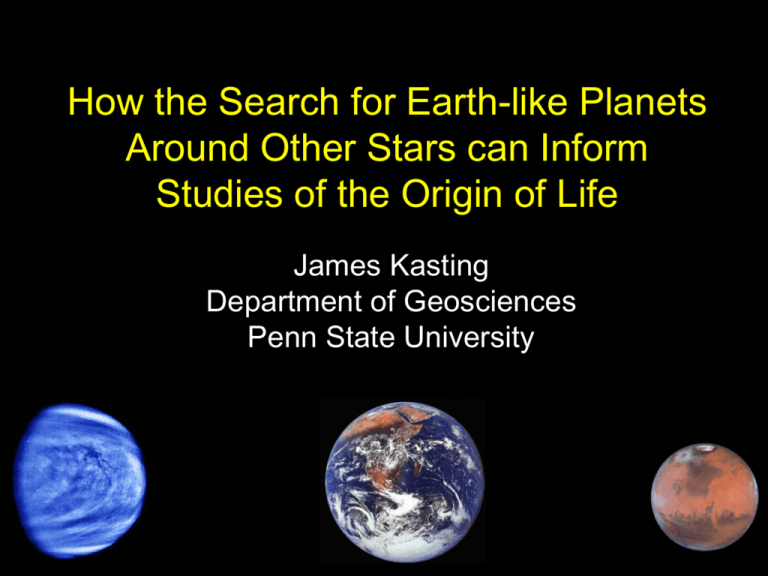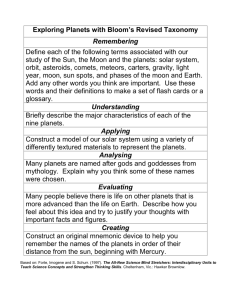habitable zone
advertisement

How the Search for Earth-like Planets Around Other Stars can Inform Studies of the Origin of Life James Kasting Department of Geosciences Penn State University • Two quick thoughts about early atmospheric composition and climate, inspired by talks earlier in the meeting • First, the prebiotic atmosphere was not highly reducing, but CO could have been an important source of metabolic energy for early life • CO is way out of equilibrium with H2 in early atmosphere models because 1. It is produced by photolysis of CO2 2. CO does not recombine rapidly with atomic O 3. H2 escapes to space, whereas CO does not Fig. 1 Water-gas shift reaction • Energy is therefore available from the water-gas shift reaction CO + H2O CO2 + H2 • For a ‘standard’ prebiotic atmosphere (previous slide) the Gibbs free energy for this reaction is • By comparison, the free energy needed to form ATP from ADP is 35.6 kJ/mol. Many chemotrophic anaerobes can utilize reactions yielding 10-15 kJ/mol This reaction could have been utilized as a source of metabolic energy by early organisms • Second, it would probably be a mistake to think that the early Earth was uniformly hot… Paleotemperatures from O isotopes in ancient cherts • O isotopes in ancient cherts (SiO2) and carbonates have been used as evidence for warm surface temperatures early in Earth history • Taken at face value, the chert data suggest temperatures of 7015oC at 3.5 Ga P. Knauth, Paleo3 219, 53 (2005) Nature (2008) • The inferred high temperatures from O isotopes are supported by data on ‘resurrected proteins’ (various EF proteins) obtained by sequencing various microorganisms, identifying ancient genes, synthesizing the corresponding proteins, and measuring their melting points EF proteins Chert data Gaucher et al. (2008) • But the conclusion that the Archean Earth was hot is in direct conflict with the glacial record Geologic time First shelly fossils (Cambrian explosion) Snowball Earth ice ages Warm? Ice age Rise of atmospheric O2 (Ice age) Ice ages The Hadean and early Archean could have been warm, but the late Archean and early Proterozoic were probably cool • OK, now back to my advertised topic… How often has life arisen? • Perhaps the most fundamental question about the origin of life is: Did it happen more than once? – Answering this question would help us decide whether the origin of life is likely or unlikely • We can answer it either by finding life within our own Solar System or by looking for evidence of life on planets around other stars http://massufosightings.blogspot.com/ What is life? • If we are going to search for life on other planets, we first need to decide what we are looking for • One definition: “Life is a selfsustained chemical system capable of undergoing Darwinian evolution” --Jerry Joyce • This definition, however, is better suited to looking for life in a laboratory experiment than for searching remotely on planets around other stars Jerry Joyce, Salk Institute Looking for life via the by-products of metabolism • Green plants and algae (and cyanobacteria) produce oxgyen from photosynthesis: O2 CO2 + H2O CH2O + O2 • Methanogenic bacteria produce methane CO2 + 4 H2 CH4 + 2 H2O • CH4 and O2 are out of thermodynamic equilibrium by 20 orders of magnitude!* Hence, their simultaneous presence is strong evidence for life *As CH4 first pointed out by James Lovelock (Nature, 1965) Visible spectrum of Earth Integrated light of Earth, reflected from dark side of moon: Rayleigh scattering, chlorophyll, O2, O3, H2O Ref.: Woolf, Smith, Traub, & Jucks, ApJ 2002; also Arnold et al. 2002 TPF-C TPF-I/Darwin • What we’d really like to do is to build a big TPF (Terrestrial Planet Finder) telescope and search directly for Earth-like planets • We can also look for spectroscopic biomarkers (O2, O3, CH4) and try to infer whether life is present on such planets • Given current budget realities in both Europe and the U.S., these missions may not happen for a long time, but smaller versions are being studied TPF-O • What types of planets do we need to observe? • To answer this, we need to examine the requirements for life… First requirement for life: a liquid or solid surface • It is difficult, or impossible, to imagine how life could get started on a gas giant planet – Need a liquid or solid surface to provide a stable P/T environment • This requirement is arguably universal Second requirement for life: carbon • Carbon is unique among the elements in forming long, complex chains • Something like 95% of known chemical compounds are composed of organic carbon • Silicon, which is located right beneath carbon in the Periodic Table, forms strong bonds with oxygen, creating rocks, not life Proteins Third requirement for life (as we know it) : Liquid water • Life on Earth requires liquid water during at least part of its life cycle • So, our first choice is to look for other planets like Earth • Subsurface water is not relevant for remote life detection because it is unlikely that a subsurface biota could modify a planetary atmosphere in a way that could be observed (at modest spectral resolution) The habitable zone • This leads directly to the concept of the habitable zone, also referred to as the ecosphere, or (Shapley, 1938) the liquid water belt • Figure applies to zero-age-main-sequence stars; the HZ moves outward with time because all main sequence stars brighten as they age http://www.dlr.de/en/desktopdefault.aspx/tabid-5170/8702_read-15322/8702_page-2/ Determining the frequency of Earth-like planets • Earth—the fraction of stars that have at least one rocky planet in their habitable zone – This is what we need to know in order to design a space telescope to look for such planets around nearby stars Kepler Mission • This space-based telescope will point at a patch of the Milky Way and monitor the brightness of ~160,000 stars, looking for transits of Earthsized (and other) planets • 105 precision photometry • 0.95-m aperture capable of detecting Earths • Launched: March 5, 2009 • Died (mostly): April, 2013 http://www.nmm.ac.uk/uploads/jpg/kepler.jpg Kepler target field: The stars in this field range from a few hundred to a few thousand light years in distance December 2011 Kepler data release Candidate label Candidate size (RE) Earth-size Rp < 1.25 Super-Earths 1.25 < Rp < 2.0 Neptune-size 2.0 < Rp < 6.0 Jupiter-size 6.0 < Rp < 15 Very-large-size 15 < Rp < 22.4 TOTAL Number of candidates 207 680 1181 203 55 2326 • Planets bigger than about 2 Earth radii (~10 Earth masses) are expected to capture gas during their formation and turn into gas or ice giants The Earth’s and super-Earths are potentially habitable Source: Christopher Burke, AAS presentation, Long Beach, CA, Jan. 7, 2013 Published Earth estimates • Recently, Petigura et al. published an estimate of Earth for K stars and (one) late-G star • They got 0.22, but they assumed a HZ of 0.5-2.0 AU, which is too wide, so a conservative estimate might be ~0.1 • By comparison, published estimates of Earth for M stars are of the order of 0.4-0.6 (Kasting et al., PNAS, 2014, and refs. therein) 0.5 1.0 AU Petigura et al., PNAS (2013) 2.0 Conclusions • CO could have been an important source of metabolic free energy for early organisms • The early Earth was relatively cool by 2.9 Ga, but it could have been hot earlier in its history – That said, hyperthemophilia near the base of the rRNA tree could be explained if early life was confined to hydrothermal vents • Earth-like planets appear to be reasonably abundant around various classes of main sequence stars • Ultimately, we need to fly some kind of TPF mission to directly image Earth-sized planets, to characterize their atmospheres, and to look for evidence of life – If we find it, we will know that the origin of life is not a rare event, and that, in turn, could help us determine how it happened








